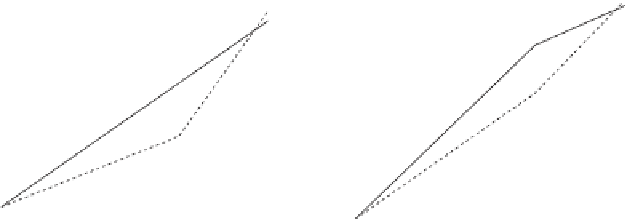Agriculture Reference
In-Depth Information
(b)
(a)
60
60
50
50
40
40
30
30
20
20
10
10
0
1
10
100
1000
1
10
100
1000
Area (m
2
)
Area (m
2
)
Australia
California
Fig. 11.3
Species-area curves for California chaparral and southwest Australian heathlands
with the (a) exponential model plotted on a semi-log scale and (b) power model plotted on a
log-log scale.
characteristics about global scale diversity patterns (Rosenzweig
1995
). Far less
attention, however, has been focused on comparative studies of this species-area
relationship at the scale of individual plant communities and the potential insights
it might give into factors driving community assembly (Keeley & Fotheringham
2003b
).
MTC plant communities differ markedly in their community-scale species-area
relationships and there is reason to believe the differences are driven by different
functional types selected in response to the climate, fire, geology filter (see
Fig. 1.4
). For example, following fire, species-area curves are very different
between California chaparral and Western Australian heathland communities.
Across the scales from 1 to 1000 m
2
, chaparral fits a power model and heathland
exhibits a better fit to an exponential model (
Fig. 11.3
).
It is hypothesized that these different model fits are the result of different
dominance-diversity relationships tied to life history differences (Keeley &
Fotheringham
2003b
) and this is evident in very different species-abundance
curves (Keeley
2003
).
Chaparral dominance-diversity patterns fit a geometric model (
Fig. 11.4a
,
b
)
and species-abundance curves are very broad with many uncommon species
indicating diversity is controlled by the strong dominance of a few species with
many subordinate species. This arises because most of the postfire flora comprises
obligate and facultative seeders and a small number of vigorous resprouters,
which often dominate postfire cover. Although postfire endemics are usually
abundant, the majority of annuals occur in relatively small numbers and much
of this annual diversity is relatively transient. The vast majority are
satellite




















































